Overview
The central inquiry of this article is how to develop a successful winery app. To address this, we present five essential steps:
- Identify customer needs
- Define core features
- Select the right technology
- Conduct testing and gather feedback
- Implement effective marketing strategies
Each of these steps is critical for enhancing user engagement and ensuring that the app aligns with consumer expectations. By following this structured approach, stakeholders in the wine industry can create an app that not only meets but exceeds user demands.
Introduction
Creating a winery app transcends mere technology; it demands a profound understanding of the evolving preferences of wine enthusiasts, delivering a tailored experience that resonates deeply with them. As consumers increasingly pursue personalization and sustainability, wineries possess a unique opportunity to leverage these insights to enhance customer engagement and drive sales. The challenge, however, lies in effectively translating customer feedback into actionable app features that not only attract users but also cultivate loyalty.
What essential steps must be taken to ensure a winery app stands out in this competitive market?
Identify Customer Needs and Preferences
To create a successful winery app, starting with targeting your existing customers is imperative. This foundational step allows you to gather invaluable insights into their preferences and needs. Focus on questions that delve into their wine buying habits, preferred communication methods, and the features they desire in an app. Notably, recent trends reveal that consumers are increasingly prioritizing personalization and sustainability; thus, incorporating these elements into your inquiries is essential.
Furthermore, a thorough analysis of customer feedback from your website and social media platforms will help identify recurring themes and sentiments. This wealth of information enables you to craft detailed profiles that accurately represent your target demographic, allowing for the customization of the app's features to enhance satisfaction and engagement. By aligning your winery app development closely with customer insights, you can ensure it meets the evolving expectations of modern wine consumers.
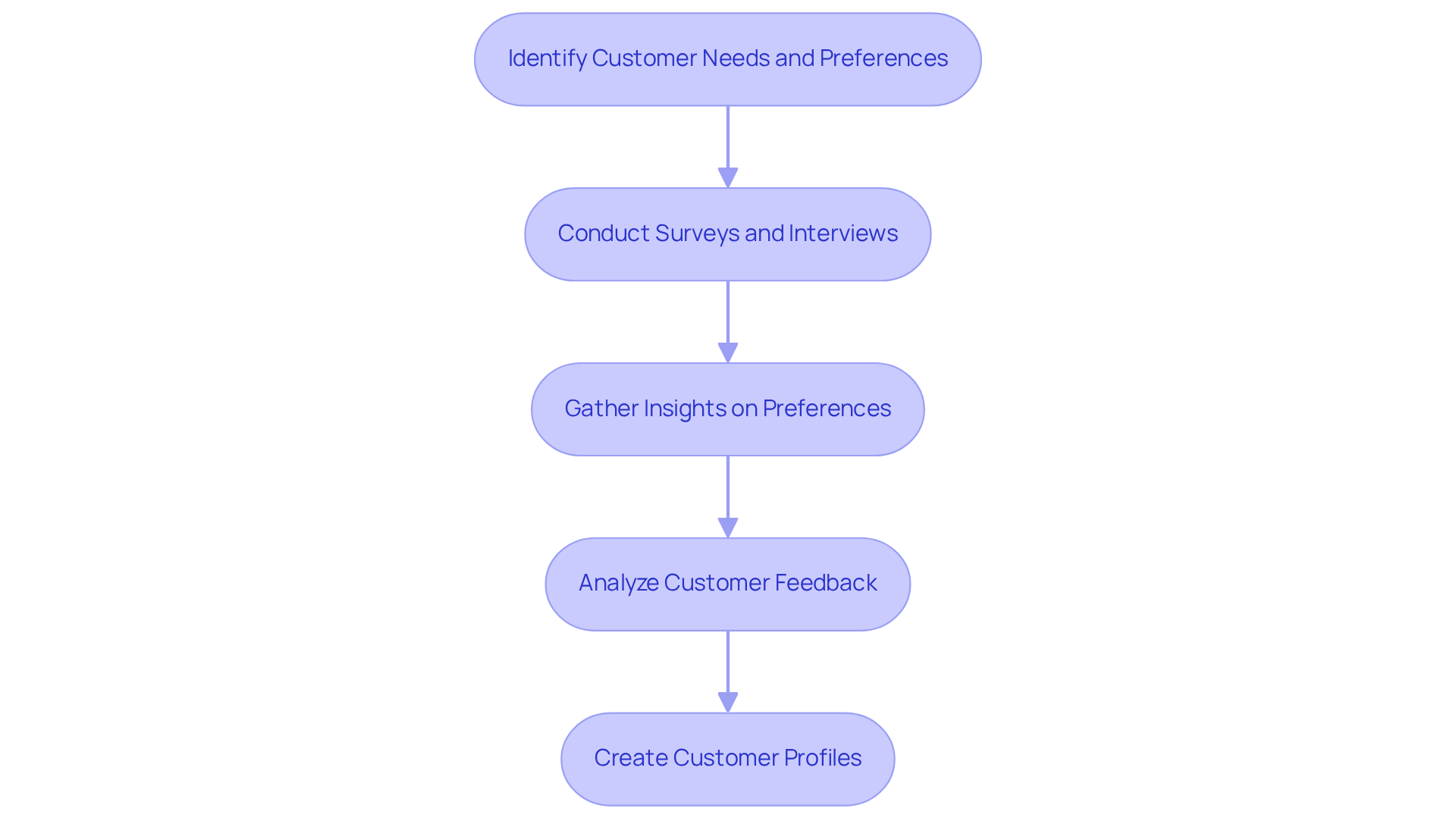
Define Core Features for Enhanced Engagement
To create a successful winery app, it is essential to define core features that significantly enhance engagement and drive . Consider the following key functionalities:
- Wine Catalog: A comprehensive catalog showcasing your wines, complete with tasting notes and pairing suggestions, allows users to explore your offerings in depth, encouraging purchases.
- Personalized Recommendations: By leveraging data-driven insights, you can provide tailored wine suggestions based on individual preferences and past purchases. This approach not only enhances the shopping experience but also fosters loyalty, which is crucial for revenue growth.
- Wine Club Membership Management System: Streamlining the administration of wine club memberships is vital. This system allows individuals to easily register, renew, and oversee their subscriptions. Notably, 27% of new wine club signups originate from digital channels; enhancing this aspect can convert casual purchasers into dedicated club members, thereby fostering steady growth in DTC revenue.
- Event Notifications: Keeping individuals informed about upcoming events, tastings, and promotions through timely alerts encourages participation and engagement, which can lead to increased sales.
- Social Sharing Options: Incorporating features that enable individuals to share their experiences on social media fosters community and enhances brand visibility, ultimately attracting new clients.
- Tasting Notes Section: Motivating individuals to record their tasting experiences not only boosts engagement but also fosters a personal connection to your wines, encouraging repeat purchases.
- Loyalty Rewards Program: Implementing a rewards system that incentivizes repeat purchases fosters customer loyalty. Engaged customers can generate 2.6 times more revenue than those who are less satisfied, aligning with proven strategies for cultivating loyalty in family-owned vineyards.
By emphasizing these aspects, your winery app can greatly enhance engagement, foster a vibrant community around your brand, and ultimately promote enduring customer loyalty while boosting your DTC strategies.
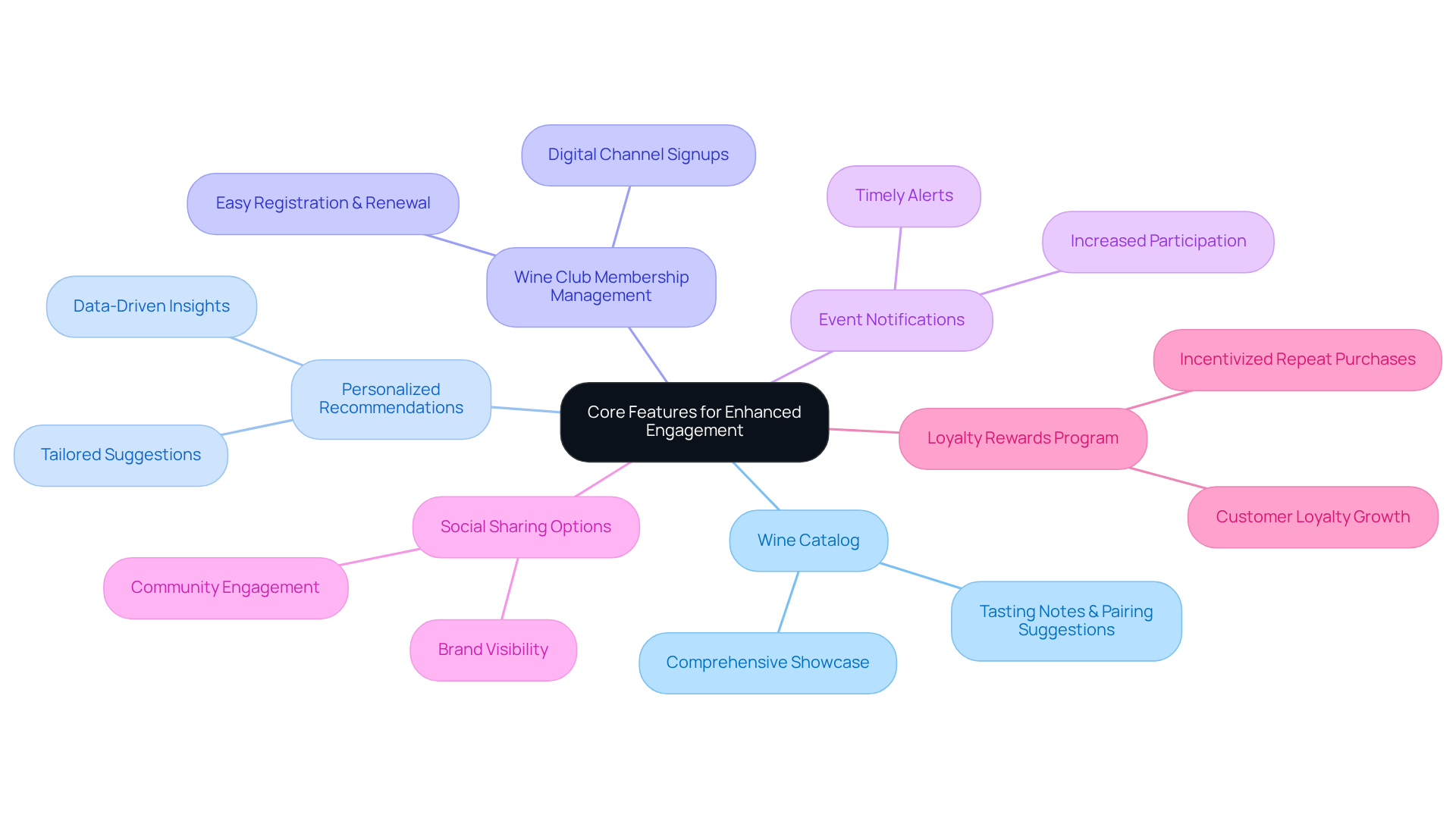
Choose the Right Technology and Platform
When selecting an for vineyards, it is essential to evaluate native, hybrid, and web-based options, taking into account budget constraints and the specific needs of the target audience. Native applications, designed exclusively for iOS or Android, deliver exceptional performance and user experience, making them ideal for applications that demand high interactivity and access to device features. However, they come with elevated development costs and extended timelines, with estimates ranging from $50,000 to over $250,000 per platform. Additionally, native applications incur 10-20% higher project management costs compared to hybrid applications, a critical consideration for budget-sensitive businesses.
Conversely, hybrid apps, which integrate web technologies with native containers, offer a cost-effective solution, enabling a single codebase to be deployed across multiple platforms. Frameworks such as React Native and Flutter empower wineries to effectively engage both iOS and Android audiences, with React Native facilitating reductions in development costs by approximately 30-50%. Furthermore, React Native enables developers to maintain two codebases while allowing for updates without the need for the App Store review process, thus enhancing efficiency. Nevertheless, hybrid applications may face performance trade-offs, including slower load times—3-4 seconds for hybrid applications versus 1-2 seconds for native applications—and increased resource consumption, potentially leading to customer churn. Users are also 8.4% more likely to experience usability issues in hybrid apps compared to native ones, further reinforcing the case for native solutions.
Web-based solutions, while offering the advantage of easy updates and accessibility through browsers, often lack the performance and engagement levels characteristic of native applications. They may also encounter challenges with features such as push notifications on iOS, which can limit user interaction.
To ensure that the chosen technology aligns with the critical functions outlined for the beverage application, collaboration with a skilled development team is paramount. This team should emphasize scalability, facilitating future updates and feature additions. As vineyards increasingly strive to enhance their direct-to-consumer engagement, selecting the right app development platform can significantly impact their success in a competitive market. As industry experts assert, "An app that fails to capture the imagination of a first-time individual is unlikely to regain traction with that same individual in the future," underscoring the importance of engagement in app development.
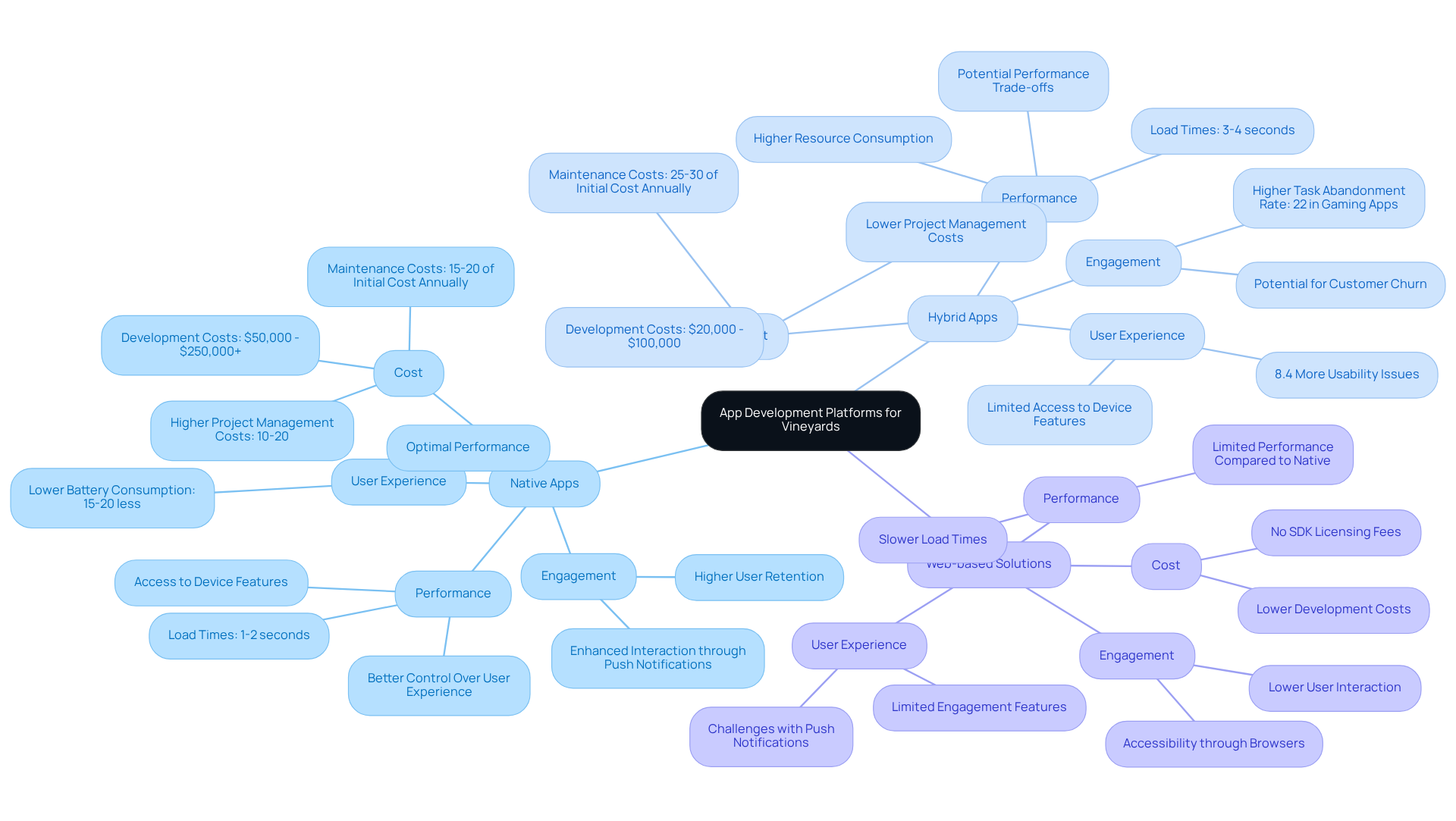
Conduct Testing and Gather User Feedback
Following the development of the app, it is imperative to conduct thorough testing to identify bugs and usability issues. Introducing a beta testing phase with a carefully selected group of customers allows wineries to gather invaluable feedback regarding the app's functionality and interface. Encouraging testers to share their authentic experiences—particularly on navigation, the usefulness of functionality, and overall satisfaction—can reveal critical insights. For example, statistics show that 29% of users will abandon an app if it fails to deliver value, emphasizing the importance of aligning app features with user expectations. Moreover, with over half of downloaded applications going unused, effective feedback mechanisms are vital for ensuring app relevance and sustaining user engagement.
To optimize the feedback collection process, wineries can implement various strategies, such as:
- Surveys
- Direct interviews
This approach not only aids in identifying areas for improvement but also fosters a sense of community among participants, enhancing brand loyalty. As usability testing experts assert, "Beta testing enables the early identification of problems, ensuring a smooth experience for participants and delivering a high-quality product that meets the expectations of your target audience."
By leveraging this feedback to make necessary adjustments before the official launch, vineyards can guarantee that their application functions seamlessly and resonates with users, ultimately boosting engagement and satisfaction in a competitive market.
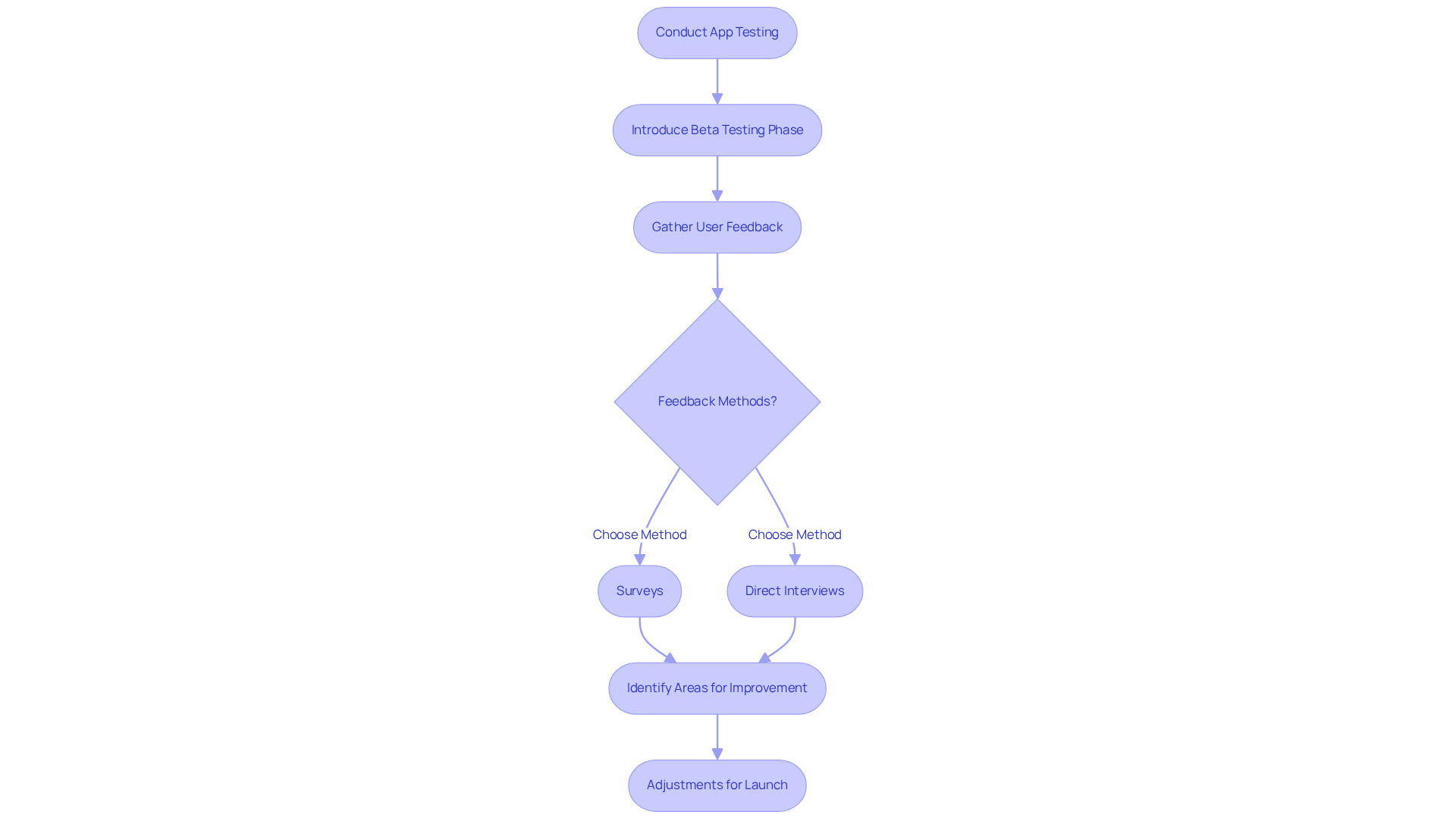
Launch the App and Implement Marketing Strategies
To successfully launch your winery app, it is essential to develop a comprehensive marketing plan that prioritizes:
- Social media promotions
- Targeted email campaigns
- Collaborations with influential figures in the wine industry
Begin by leveraging your existing customer base; send announcements and offer exclusive promotions to early adopters, creating a sense of urgency and excitement. Organizing a launch event at your establishment can further amplify this excitement and promote downloads, providing a tangible experience that connects individuals to your brand. Additionally, consider hosting VIP events and experiences for loyal customers to strengthen their bond with your establishment.
Following the launch, it is crucial to sustain audience engagement through:
- Regular updates
- The introduction of new features
- The provision of personalized content that resonates with your viewers
This ongoing interaction not only maintains interest but also fosters loyalty, ensuring that your app remains a valuable tool for your customers. Data indicates that vineyards leveraging social media for promotions have experienced significant growth in engagement, with 27% of new wine club registrations originating from online platforms. Furthermore, the number of online wine buyers surged from 1.5 million to 4.1 million, underscoring the growing market for winery apps and the importance of digital engagement.
By effectively utilizing these strategies, your establishment can cultivate a vibrant community around your app, enhancing both downloads and long-term engagement. Enocap's expertise in direct-to-consumer strategies can further elevate your marketing efforts, transforming casual buyers into loyal club members. As Eric Asimov highlights, focusing on flavor and user experience is vital for resonating with consumers' preferences. Additionally, leveraging user-generated content can inspire others to engage with your brand, further enhancing your app's visibility and appeal. To explore how Enocap can assist with strategic capital planning and maximize your winery's growth potential, schedule a complimentary growth audit today.
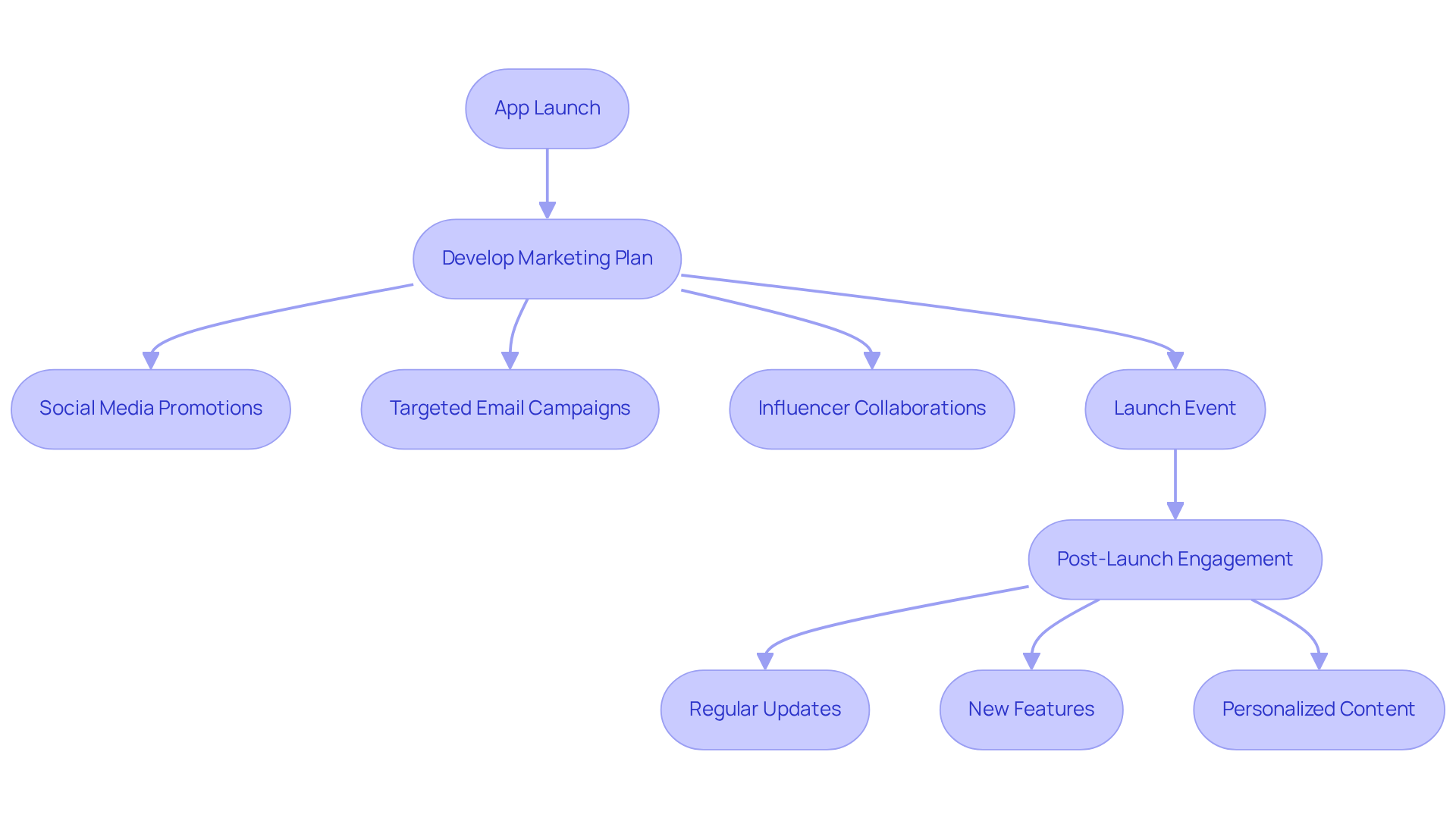
Conclusion
Creating a successful winery app fundamentally relies on a profound understanding of customer needs and preferences. This insight serves as the cornerstone for developing features that genuinely resonate with users. By prioritizing personalization, sustainability, and engagement, wineries can craft applications that not only attract but also retain customers, ultimately driving direct-to-consumer revenue.
Throughout the development process, defining core features such as personalized recommendations, a comprehensive wine catalog, and effective membership management systems is critical. Furthermore, selecting the right technology and conducting thorough testing with user feedback ensures that the app meets audience expectations. A robust marketing strategy that leverages social media and targeted campaigns can significantly elevate the app’s visibility and encourage user adoption.
In the competitive landscape of winery apps, the emphasis on user experience and engagement is paramount. By implementing these strategies, wineries can cultivate a loyal customer base, foster community, and enhance their brand presence. Investing in a well-designed app transcends mere technology; it’s about creating an ongoing relationship with consumers that celebrates their love for wine. Embrace these steps to ensure that your winery app stands out and thrives in the digital marketplace.
Frequently Asked Questions
What is the first step in creating a successful winery app?
The first step is to conduct comprehensive surveys and interviews with existing customers to gather insights into their preferences and needs regarding wine buying habits, communication methods, and desired app features.
Why is it important to analyze customer feedback from websites and social media?
Analyzing customer feedback helps identify recurring themes and sentiments, allowing for the creation of detailed profiles that represent the target demographic. This information can be used to customize the app's features to enhance customer satisfaction and engagement.
What recent trends should be considered when developing a winery app?
Recent trends indicate that consumers are prioritizing personalization and sustainability, so these elements should be incorporated into the app development process.
What are some core features that enhance engagement in a winery app?
Core features include a wine catalog, personalized recommendations, a wine club membership management system, event notifications, social sharing options, a tasting notes section, and a loyalty rewards program.
How does a wine catalog benefit users?
A wine catalog provides a comprehensive showcase of wines, complete with tasting notes and pairing suggestions, allowing users to explore offerings in depth and encouraging purchases.
What role do personalized recommendations play in a winery app?
Personalized recommendations leverage data-driven insights to provide tailored wine suggestions based on individual preferences and past purchases, enhancing the shopping experience and fostering customer loyalty.
Why is a wine club membership management system important?
A wine club membership management system streamlines the administration of memberships, making it easy for individuals to register, renew, and oversee their subscriptions, which can convert casual purchasers into dedicated club members.
How can event notifications impact customer engagement?
Event notifications keep individuals informed about upcoming events, tastings, and promotions, encouraging participation and engagement, which can lead to increased sales.
What is the benefit of incorporating social sharing options in the app?
Social sharing options allow individuals to share their experiences on social media, fostering community and enhancing brand visibility, which can attract new clients.
How does a loyalty rewards program contribute to customer loyalty?
A loyalty rewards program incentivizes repeat purchases, fostering customer loyalty, as engaged customers can generate significantly more revenue than less satisfied ones.




